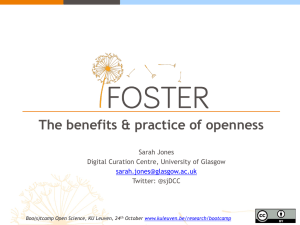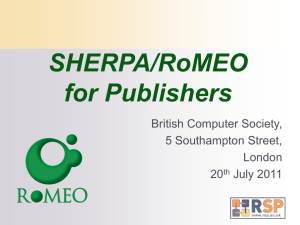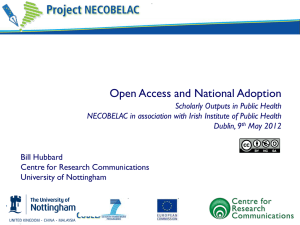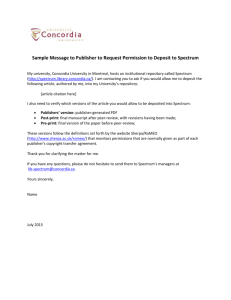Institutional Repositories *Research cited more, safe forever
advertisement
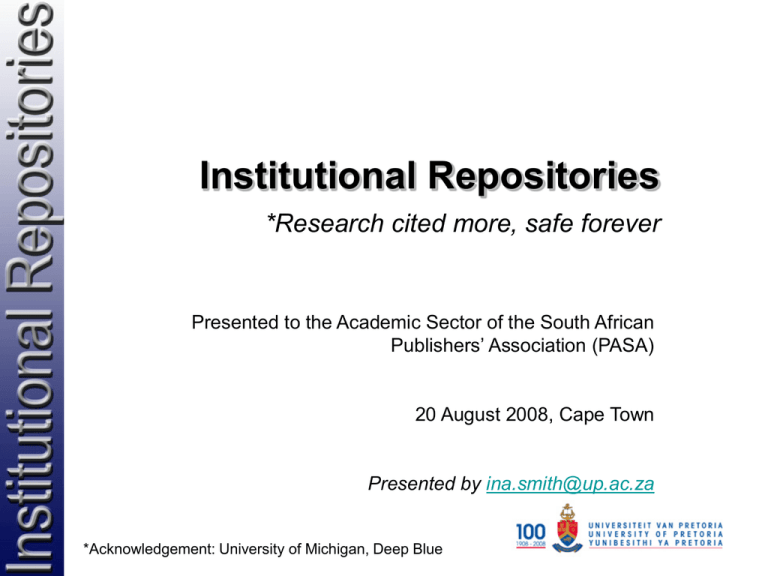
Institutional Repositories *Research cited more, safe forever Presented to the Academic Sector of the South African Publishers’ Association (PASA) 20 August 2008, Cape Town Presented by ina.smith@up.ac.za *Acknowledgement: University of Michigan, Deep Blue Research @ Higher Education Institutions UNISA • • • “Enhance scholarly stature of the University” “Combination of research and community service is important” – transfer research to community “Disseminate research findings [in many forms e.g. reports, books, articles, media] – so that they may be confirmed, evaluated, applied by others Source: UNISA Research Policy www.unisa.ac.za University of Pretoria • • “promote scholarship through the creation, advancement, application, transmission and preservation of knowledge” “ensuring that the university’s library and information services can give academics access to the information they need” Source: UP Research Policy www.up.ac.za What is Open Access? (1) "There are many degrees and kinds of wider and easier access to this literature. By 'open access' to this literature, we mean its free availability on the public internet, permitting any users to read, download, copy, distribute, print, search, or link to the full texts of these articles, crawl them for indexing, pass them as data to software, or use them for any other lawful purpose, without financial, legal, or technical barriers other than those inseparable from gaining access to the internet itself. The only constraint on reproduction and distribution, and the only role for copyright in this domain, should be to give authors control over the integrity of their work and the right to be properly acknowledged and cited." – Budapest OA Initiative Source: http://www.earlham.edu/~peters/fos/overview.htm What is Open Access? (2) “For a work to be OA, the copyright holder must consent in advance to let users "copy, use, distribute, transmit and display the work publicly and to make and distribute derivative works, in any digital medium for any responsible purpose, subject to proper attribution of authorship...." – Bethesda & Berlin Statements on OA Source: http://www.earlham.edu/~peters/fos/overview.htm What Open Access is not • Does not affect peer-review; articles are peerreviewed and published as always • No suggestion that authors should use IR’s instead of journals • OA repositories supplement and do not replace journals • OA serves to reduce plagiarism – chance that plagiarism is detected – much higher Source: http://www.sherpa.ac.uk/guidance/authors.html#whatoa Two currents in Open Access movement • OA self-archiving in institutional repositories (“green” road to OA) • OA publishing (“gold” road to OA – see e.g. DOAJ, HSRC Press) What is an Institutional Repository? “A university-based institutional repository is a set of services that a university offers to the members of its community for the management and dissemination of digital materials created by the institution and its community members. It is most essentially an organizational commitment to the stewardship of these digital materials, including long-term preservation where appropriate, as well as organization and access or distribution.” Clifford A. Lynch, "Institutional Repositories: Essential Infrastructure for Scholarship in the Digital Age" ARL, no. 226 (February 2003): 1-7 Impact of Open Access via an IR Research on IR Increase visibility, usage, impact Increase in citation rate Impact on NRF, ISI Ratings, H-index etc. Shanghai List & THES Repositories worldwide Source: http://www.opendoar.org/ 13 Registered SA Repositories • • • • • AHERO (African Higher Education Research Online) CSIR Research Space DUT IR Electronic Thesis and Dissertation Database (UJ) UPSpace (Institutional Research Repository University of Pretoria) • Rhodes eResearch Repository (ReRR) • Stellenbosch University Institutional Repository • UCT Computer Science Research Document Archive (UCT CS Archive) • UJDigispace • Unisa ETD • University of Pretoria Electronic Theses and Dissertations (UPeTD) • University of the Witwatersrand • UWC Theses and Dissertations Institutional Repository Workshops • • • • NRF (9) (17 & 18 June 2008) CHELSA (17) (28 – 30 July 2008) General (50) (1 – 3 October 2008) African Digital Scholarship & Curation Conference (14 May 2009) • General IR Workshop (7 – 9 July 2009) Content types worldwide Source: http://www.opendoar.org/ https://www.up.ac.za/dspace/ Digitally born & digitized material Photos Research articles Drawings after being digitized Research articles with accompanying data sets E-mails Audio, Video clips Newspaper articles Special Collections Inaugural addresses Web pages Theses & Dissertations Institutional Repository Structure Top-Level Community • Faculty e.g. Economic and Management Sciences Sub-Community • Department e.g. Accounting Collections Research Articles (pre- & post-prints) Conference Papers/ Presentations Theses & Dissertations Chapters from Books Research Reports etc. Persistent URL Metadata Full text Workflow prior to submission (prepare item for submission) Copyright Clearance Scan/ Digitize Edit Submit to IR Workflow within Institutional Repository Review item Edit metadata Available on IR Notification to Submitter & Subscribers Reject Submit item Benefits • Increases visibility, usage, impact of research “open access papers are read more widely, and, therefore, cited more frequently. The consequence of this is that they have greater impact” (Jones, Andrew and MacColl 2006) • Highly retrievable via search engines e.g. Google, Google Scholar because of metadata • Can access research conducted by own researchers published in non-subscription databases/ journals Benefits (cont.) • Research out quickly, worldwide • Open access to all – also those who cannot afford subscribing • Central archive of research • Persistent URL • Preservation function • Full text searchable • E-workflow for quality control • Distributed/ decentralised input • Limit access on various levels • Information Model (Communities & Collections) Benefits for Publishers • “Makes growth of both new & existing journals much easier” • “Shift to OA will promote more competition between publishers, which will enable many smaller publishers to gain a competitive edge over the largest and mostestablished publishing houses” • “An OA publishing model will make a journal far more attractive to potential authors, since they can avoid many of the unnecessary limitations imposed by subscription-based models” (Paul Peters, Senior Publishing Developer of Hindawi Publishing Corporation) Copyright • Individual authors usually retain copyright and only s/he can transfer copyright to a publisher (whether book, article, conference proceeding) • Copyright of a publication usually goes to the publisher but permission to reprint (under certain conditions) is usually granted • Approaches to clear copyright: – SHERPA/ RoMEO (for research articles only) – Publishers’ web sites – Directly contact copyright owner & negotiate http://www.sherpa.ac.uk/romeo.php Currently: 400 policies registered Colour coding in SHERPA RoMEO • Green: Can archive pre-print and post-print • Blue: Can archive post-print (i.e. final draft postrefereeing) • Yellow: Can archive pre-print (i.e. pre-refereeing) • White: Archiving not formally supported Elsevier Conditions for archiving on an IR Research funders’ open access policy BioMed Central CAB International Publishing Cambridge University Press John Wiley & Sons Kluwer Philosophical Society of Southern Africa Springer Verlag http://www.sherpa.ac.uk/romeoupdate.php http://www.oxfordjournals.org/access_purchase/selfarchiving_policya.html http://library.isikun.edu.tr/Blackwell.htm Gold road http://www.blackwellpublishing.com/static/selfarchive.as p Green road Restricted access to full text Publisher & Citation Restricted access – item under embargo Embargo period applies to full text Restricted access Permission for open access to full text Publisher & Citation UPSpace Letters of Consent Collection Colour coding according to SHERPA RoMEO Conditions for archiving, if any Communication & original letters of consent archived for future reference Licensing License stored with each item – Submitter grants license http://www.dspace.up.ac.za/defaultlicense.pdf “By submitting this license, you (the owner of the rights or on behalf of the owner of the rights) grants to the University of Pretoria the non-exclusive right to reproduce, translate (as defined below), and/or distribute your submission (including the abstract) worldwide in print and electronic format and in any medium, including but not limited to audio or video.” http://www.youtube.com/watch?v=g2JT23E1bRE BioMed Central's authors and editors discuss the benefits of open access publishing Conclusion • Embrace Open Access • IR’s not a threat, but supplement work done by publishers • Open Access can benefit publishers in many ways – more exposure • Formulate policies on archiving within IR’s and make available on SHERPA/ RoMEO • Revisit agreements with authors (Minimum Terms Agreement) • Embrace Web 2 opportunities – e.g. AdSense (Google) • Change in Business Model? • Work as partners with HEI’s – we are on the same side … Bibliography • • • • • Jones, R, Andrew, T & MacColl, J 2006, “The institutional repository.” Oxford, England: Chandos Publishing. Lynch, CA 2003, "Institutional Repositories: Essential Infrastructure for Scholarship in the Digital Age" , ARL, no. 226, pp. 1 – 7 OpenDOAR http://www.opendoar.org SHERPA/RoMEO http://www.sherpa.ac.uk/romeo.php UNISA Research Policy www.unisa.ac.za UP Research Policy www.up.ac.za • YouTube http://www.youtube.com/watch?v=g2JT23E1bRE • Acknowledgement Each individual who has contributed towards taking the UPSpace and IR initiative forward, and who are part of the UPSpace team Thank you! upspace@up.ac.za
